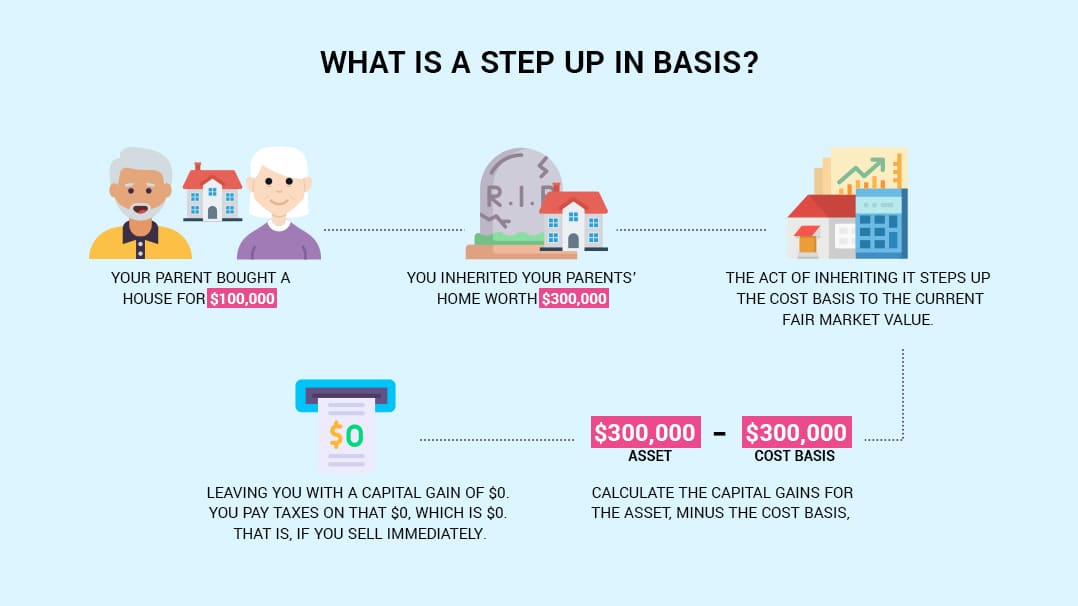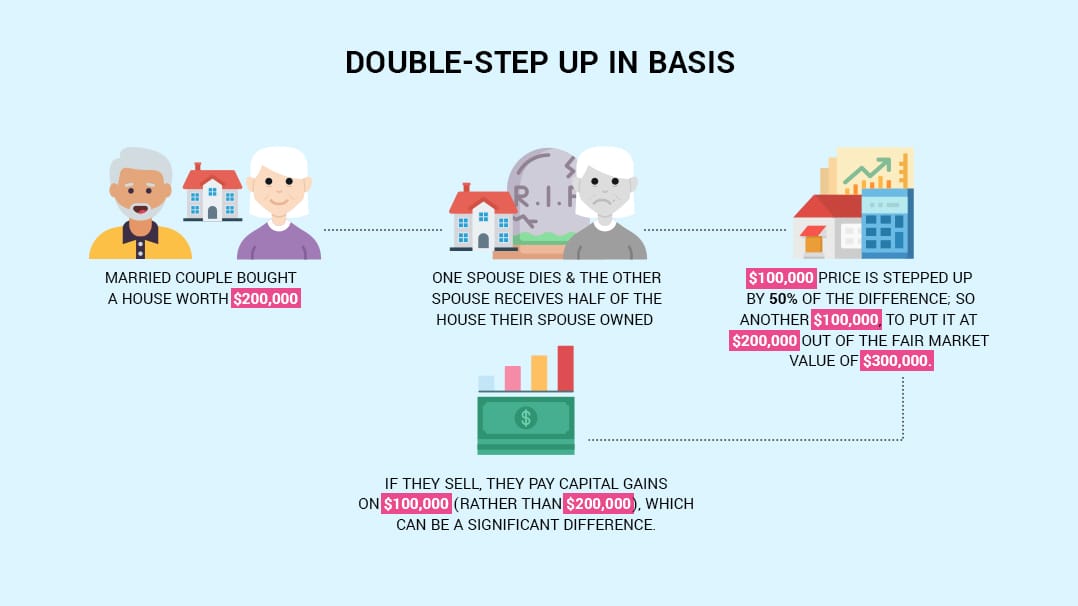
How Proposition 19 Affects Inherited Property for Californians
April 21, 2023
Ultimate Guide to Property Taxes in San Diego (Updated 2023)
May 5, 2023
Disclaimer: I am not an attorney and this article is not intended as a substitute for advice from the appropriate legal, zoning, financial, construction and/or tax professionals. This information is provided for educational purposes only and is made without warranties or representations
When considering real estate, there are a lot of different ways that value is calculated and how that value applies to other calculations. One important concept is the “step-up in basis” that occurs upon inheriting property.
There are a few key concepts you need to learn as you understand how inheriting property affects your taxes, so let’s start from the beginning.
Why Step-Up in Basis Matters
First of all, let’s talk about who this applies to and why it matters. Specifically, a step-up in basis applies to people who inherit property and are worried about the taxes they’ll need to pay on the assets they receive.
Usually, when someone transfers a significant asset to you – like a car, a stock portfolio, or a house – and you choose to sell it, you’ll need to pay capital gains taxes on the value of that asset. You’re receiving something of monetary value and then selling it for that value, and that receipt of value triggers income taxes.
Note that not all states assess a capital gains tax. California is one of the states that do; they evaluate it as part of income tax, so the actual calculation of how much you’ll owe on the capital gains will depend in part on the asset’s value and, in part, on the rest of your income.
However, don’t start worrying just yet; the step-up in basis is an important concept here.
“When you sell an asset for profit in California, you will be taxed on the capital gain you make. This applies to stock, bonds, real estate, cars, and most other assets you sell.
California does not have a separate capital gains tax rate, unlike some jurisdictions. California taxes you on the profit of your residential sale as if it were ordinary income you earned. The tax rate will depend on your marginal tax when calculating your California income tax.
The California capital gains tax applies to profits you make when you sell certain like cars, stocks, bonds, and real estate. These profits are taxed as regular income. When calculating your California capital gains tax, you need to know your marginal tax bracket.” – Tax Shark.
A capital gain – which triggers capital gains taxes – occurs when you receive an asset and sell it for more than you paid. For example, you buy a stock portfolio worth $50,000 and later sell it for $80,000. The difference between the two — $30,000 – is considered taxable income, a capital gain. You don’t have to pay taxes on the entire 100k, nor do you have to pay the standard income tax rate, but you do have to pay capital gains taxes on the 30k that you acquired.

Conversely, if the stock portfolio lost price and you sold it for $25,000, you’d experience a capital loss, but that’s not terribly relevant to today’s discussion.
The original purchase price of the asset – so, $50,000 in this stock example – is your cost basis.
It’s the benchmark against which the later sale price is measured.
Now let’s go back to the scenario of inheritance. Say your parent passes away, and their house passes to you. The home, worth $300,000, is now in your possession. You don’t want to do anything with it, so you decide to sell it and put that money towards something more relevant to your life.
What’s the cost basis for the house you inherited? You didn’t buy it, so you need to look back at what it was worth when it was purchased.
For example, if your parents bought it 30 years ago for $100,000, that sets the cost basis of the property at $100,000.
When you sell, then, your capital gain would be $200,000. You then pay capital gains taxes on that. This value puts it in the 15% tax bracket, so you’d be looking at paying around $30,000 in taxes (well, not entirely; tax calculations are more complicated than that, but for our purposes, a simple example is easier to visualize.)
Inheriting an asset worth $300,000 but being on the hook for a significant amount of taxes because of it can be a sticky situation to be in. Luckily, the “step-up in basis” loophole exists.
What is a Step-Up in Basis?
A “step-up in basis” in real estate refers to a change in the tax cost basis of an inherited property. When someone inherits a property, the value of the property for tax purposes is reset to its current fair market value. This means that the new owner’s tax basis in the property is “stepped up” to its value at the time of inheritance rather than the original purchase price paid by the previous owner.
To go back to our example above, consider that you inherited your parents’ home worth $300,000. They originally bought it for $100,000, but that doesn’t matter. Instead, the act of inheriting it steps up the cost basis to the current fair market value. In this case, the fair market value is $300,000.
Now you calculate the capital gains for the asset as $300,000 minus the cost basis, which is stepped up to $300,000, leaving you with a capital gain of $0. You pay taxes on that $0, which is $0. That is – if you sell immediately.
The benefit of a step-up in basis is that it reduces the capital gains tax liability for the inheritor if they choose to sell the property in the future. When the property is sold, the capital gains tax is calculated based on the difference between the sales price and the tax basis.

With a stepped-up basis, the potential capital gains tax liability is lower because the tax basis has been increased to the current market value rather than the original purchase price.
“Step-up in basis is also referred to as “the step-up in cost basis loophole.” It is especially important for California residents, as well as residents of other states, who expect to inherit assets, in particular assets that may carry a large capital gain such as real property. Most of the time, when a property is inherited, it is sold for much more than its original purchase price.
Let’s say you were to inherit an asset whose value has increased since it was acquired by the original owner. The initial cost basis of the investment is essentially wiped clean and replaced by its current market value. This way, the capital gain is minimized for the beneficiary. This is called a step-up in cost basis, and it is rendered upon transfer of the asset, which usually occurs upon the death of the decedent.” – Financial Alternatives.
So, if you hold the house for another 20 years (maybe renting it out, perhaps living in it), and the value rises to $500,000, your cost basis is the value you inherited it — $300,000 – rather than the original purchase price of $100,000.
The stepped-up value lingers and provides a benefit to you down the road, not just immediately.
The single most significant detail to remember about a step-up in basis is that it only applies upon the death of an individual and their asset being inherited. There is no way to recognize a step-up in cost basis without the death of the owner.
Regarding a Double-Step-Up in Basis
There’s also a concept called the double step-up in basis. Thinking about it logically, you can already guess what it is: stepping up the cost basis of the home twice.
This triggers first upon the death of one-half of a married couple. When one spouse dies, the other spouse receives a partial step-up in the cost basis of the house. They “inherit” half of the house their spouse owned, and that half is stepped up.
This is a partial step-up. If that spouse chooses to sell the house prior to passing away, they will need to pay the capital gains taxes on the partially-increased value.
Let’s return to our example for a minute. The original $100,000 price is stepped up by 50% of the difference, so another $100,000, to put it at $200,000 out of the fair market value of $300,000.

If they sell, they pay capital gains of $100,000 (rather than $200,000), which can be a significant difference.
There are a lot of little variances to this general rule. For example, if Spouse A purchased the whole home themselves before getting married to Spouse B, and then Spouse A passes away, leaving the property to Spouse B, the total cost basis step-up occurs rather than a partial. This is because the whole asset is inherited rather than half of it.

Note that you can’t jump through a few hoops to receive a free “step-up in basis” by transferring a property to a family member who is about to die and then receiving it back in the inheritance. While it sounds like it should work, the IRS recognizes that this is an exploitation of the step-up in basis rule and denies that step-up when they discover the abuse.
Does the Step-Up in Basis Apply in San Diego?
California is a land of many unique laws and rules that may not apply the way they do in other states, so it’s reasonable for a resident of this state to ask whether or not the rules apply the way they should.
Luckily, while there have been some recent changes to inherited property values, those do not interfere with the step-up in cost basis rules.
In California, Proposition 19 was recently passed, which changes the way the value of a property is reassessed upon inheritance. Previously, the value wasn’t reassessed at all until the asset was actually sold.
This allowed intergenerational asset transfers to continue to benefit from the very low original purchase price.
Specifically, if you inherited your parent’s home, the property taxes you would pay would have been the same as they had. After Proposition 19, some partial reassessment applies, and chances are your property taxes will go up.

For a more complete rundown of how Proposition 19 applies, you can read my full guide to it here. I go over what it means, the implications for inheriting property, and what the best options may be to deal with that property given the tax implications changed by Proposition 19.
Fortunately, this rule only applies to property taxes and the assessed value of the property. The cost basis is not affected, and neither is the step-up in cost basis. Fortunately for California residents, the step-up in cost basis still applies.
Since it’s a piece of data that only matters when you sell the property, it can linger as a benefit for years before you take advantage of it.
Are There Any Pitfalls or Mistakes to Avoid With a Step-Up in Basis?
Yes. There are some common mistakes people make when dealing with this rule, especially in California, where the real estate market is complex.

Here are a few examples:
- Not understanding the step-up in basis rule. Many people are not aware of the step-up in basis rule, and thus, they do not properly calculate the new cost basis for the inherited property. This could result in inaccurate reporting of capital gains and losses when the property is eventually sold, potentially leading to tax penalties.
- Failing to obtain a professional appraisal. It is essential to obtain a professional appraisal of the property at the time of the original owner’s death to establish the correct fair market value for the step-up in basis. Failing to do so could lead to disputes with the IRS or California tax authorities.
- Not considering state-specific laws. Proposition 19 limits the tax benefits for certain property transfers between parents and children or grandparents and grandchildren. Make sure to understand the implications of this proposition on your specific situation.
- Overlooking the holding period: Beneficiaries who inherit property receive a long-term holding period, regardless of how long the deceased owner held the property. This is important because long-term capital gains are typically taxed at a lower rate than short-term gains. However, some people mistakenly report their holding period as short-term, which could lead to higher taxes.
- Not considering the impact on estate taxes. Although the step-up in basis can help reduce capital gains taxes, it may increase the overall value of the estate, potentially subjecting it to estate taxes.
- Improperly allocating basis among multiple beneficiaries. If a property is inherited by multiple beneficiaries, the basis should be allocated among them according to their respective ownership interests. Failing to do so could lead to tax issues for the beneficiaries.
- Not keeping proper records. It’s important to keep accurate records of the property’s cost basis, appraisal, and other relevant documents. This will help ensure accurate tax reporting and avoid potential disputes with tax authorities.
It is essential to consult with a knowledgeable professional familiar with California’s real estate and tax laws. They can guide you through the process, help you avoid these mistakes, and ensure you take advantage of the step-up in basis rule while complying with all applicable tax regulations. If you have any questions about this process, I’d love to speak with you.
Is There a Difference in Step-Up Between Residential and Commercial Property?
Another question you might have is what properties your step-up in basis applies to.
The biggest limitation is that the step-up in basis applies only to real estate. It does not apply to other assets, like stock portfolios, trusts, life insurance policies, IRAs, or other investments.

Another common question is whether or not the step-up in basis is limited to your parents’ primary residence or if it applies to all real estate they own. Fortunately, the step-up in basis applies to any inherited property, regardless of whether or not it was a primary residence or if it was residential or commercial property.
Incidentally, if you’re inheriting commercial real estate and you’re looking to determine what the best route to handle it is, why not give me a call? As one of San Diego’s leading specialists in commercial real estate, I’ve facilitated the sale of many commercial properties. If you’ve inherited a piece of commercial real estate and you don’t have the time or the energy to figure out how to manage it, the easiest thing to do is sell it. I can help you navigate that process and make sure you get the best deal possible, so contact me today.
On the other hand, if you’ve decided you’d rather hang onto the property and rent it out, I have resources for that as well.

Erik Egelko is a veteran of the commercial real estate business with a specialized focus on Investment Property Sales. In 2021 and 2022, Erik was the #1 ranked Broker in California for one of the largest CRE Firms as well as ranked in the Top 1% of brokers nationwide. He has extensive experience in a variety of asset types including: Retail Shopping Centers, Medical Office Buildings, Industrial Properties, and Multifamily Apartment Complexes. Over the course of his career, Erik has closed over $100,000,000 of commercial property sales throughout Southern California.



